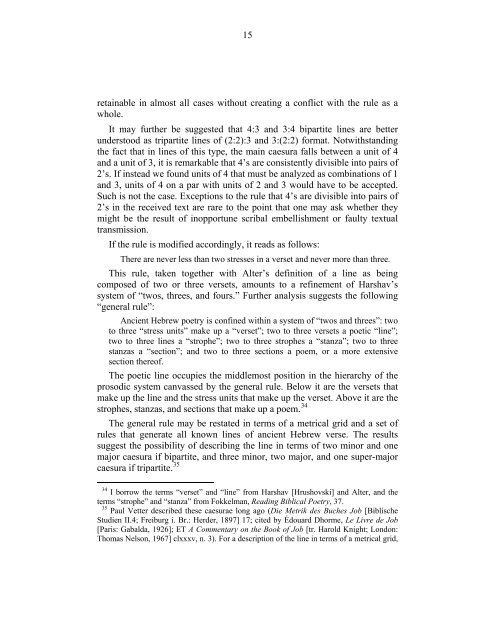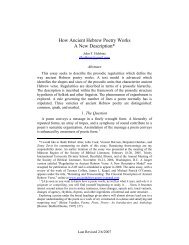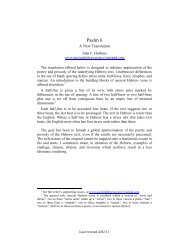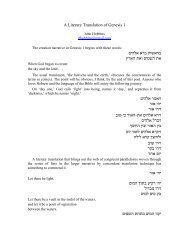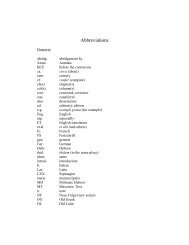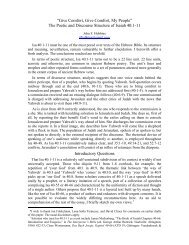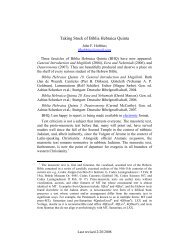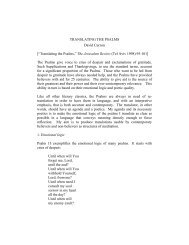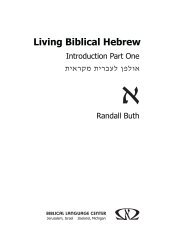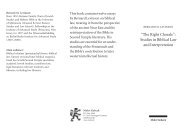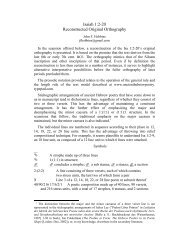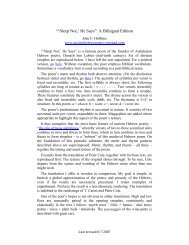Here - Ancient Hebrew Poetry - Typepad
Here - Ancient Hebrew Poetry - Typepad
Here - Ancient Hebrew Poetry - Typepad
- No tags were found...
You also want an ePaper? Increase the reach of your titles
YUMPU automatically turns print PDFs into web optimized ePapers that Google loves.
15retainable in almost all cases without creating a conflict with the rule as awhole.It may further be suggested that 4:3 and 3:4 bipartite lines are betterunderstood as tripartite lines of (2:2):3 and 3:(2:2) format. Notwithstandingthe fact that in lines of this type, the main caesura falls between a unit of 4and a unit of 3, it is remarkable that 4’s are consistently divisible into pairs of2’s. If instead we found units of 4 that must be analyzed as combinations of 1and 3, units of 4 on a par with units of 2 and 3 would have to be accepted.Such is not the case. Exceptions to the rule that 4’s are divisible into pairs of2’s in the received text are rare to the point that one may ask whether theymight be the result of inopportune scribal embellishment or faulty textualtransmission.If the rule is modified accordingly, it reads as follows:There are never less than two stresses in a verset and never more than three.This rule, taken together with Alter’s definition of a line as beingcomposed of two or three versets, amounts to a refinement of Harshav’ssystem of “twos, threes, and fours.” Further analysis suggests the following“general rule”:<strong>Ancient</strong> <strong>Hebrew</strong> poetry is confined within a system of “twos and threes”: twoto three “stress units” make up a “verset”; two to three versets a poetic “line”;two to three lines a “strophe”; two to three strophes a “stanza”; two to threestanzas a “section”; and two to three sections a poem, or a more extensivesection thereof.The poetic line occupies the middlemost position in the hierarchy of theprosodic system canvassed by the general rule. Below it are the versets thatmake up the line and the stress units that make up the verset. Above it are thestrophes, stanzas, and sections that make up a poem. 34The general rule may be restated in terms of a metrical grid and a set ofrules that generate all known lines of ancient <strong>Hebrew</strong> verse. The resultssuggest the possibility of describing the line in terms of two minor and onemajor caesura if bipartite, and three minor, two major, and one super-majorcaesura if tripartite. 3534 I borrow the terms “verset” and “line” from Harshav [Hrushovski] and Alter, and theterms “strophe” and “stanza” from Fokkelman, Reading Biblical <strong>Poetry</strong>, 37.35 Paul Vetter described these caesurae long ago (Die Metrik des Buches Job [BiblischeStudien II.4; Freiburg i. Br.: Herder, 1897] 17; cited by Édouard Dhorme, Le Livre de Job[Paris: Gabalda, 1926]; ET A Commentary on the Book of Job [tr. Harold Knight; London:Thomas Nelson, 1967] clxxxv, n. 3). For a description of the line in terms of a metrical grid,


